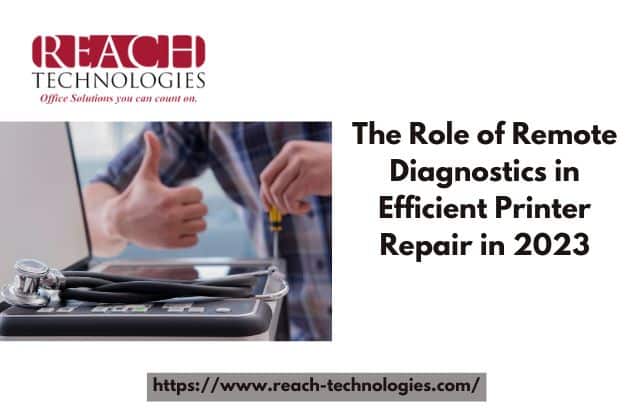In today’s fast-paced business environment, printer downtime can cause significant disruptions and productivity loss. Efficient printer repair is crucial to minimize downtime and ensure smooth operations. With advancements in technology, remote diagnostics has emerged as a valuable tool in the printer repair process. In this article, we will explore the role of remote diagnostics in efficient printer repair in 2023, highlighting its benefits, applications, and impact on the repair industry.
Understanding Remote Diagnostics
Remote diagnostics involves the use of technology to assess and diagnose printer issues remotely, without the need for a technician to be physically present at the site. Through network connectivity and specialized software, remote diagnostics enable remote IT support to troubleshoot and identify problems from a remote location.
The Benefits of Remote Diagnostics in Printer Repair
Faster Issue Resolution
Remote diagnostics significantly reduce the time required to identify and diagnose printer issues. Technicians can remotely access the printer’s software interface, review error logs, and perform diagnostic tests without being physically present. This accelerated troubleshooting process enables faster issue resolution and reduces downtime.
Cost Savings
By leveraging remote diagnostics, organizations can minimize the costs associated with printer repair. Remote troubleshooting eliminates the need for technicians to travel to the site, reducing travel expenses and saving time. Additionally, remote diagnostics enable technicians to diagnose and resolve issues more efficiently, resulting in fewer billable hours.
Increased Efficiency
Remote diagnostics streamline the repair process by providing technicians with immediate access to relevant printer information. They can remotely monitor printer status, review error codes, and analyze performance data. This real-time information empowers technicians to make informed decisions and efficiently address the root cause of printer issues.
Proactive Maintenance
Remote diagnostics enables proactive maintenance practices. Technicians can remotely monitor printer health, track usage patterns, and identify potential problems before they lead to major malfunctions. By taking preventive measures, such as firmware updates or part replacements, technicians can minimize the likelihood of future issues and optimize printer performance.
Enhanced Customer Support
Remote diagnostics improve customer support by expediting issue resolution and minimizing printer downtime. Organizations can provide remote access to technicians, allowing them to troubleshoot and resolve issues without interrupting the user’s workflow. This efficient support process enhances customer satisfaction and builds trust.
Applications of Remote Diagnostics in Printer Repair
Error Code Analysis
Remote diagnostics allows technicians to remotely analyze error codes generated by printers. By interpreting these codes, technicians can identify the specific issue and develop an appropriate repair strategy. This eliminates the need for trial-and-error troubleshooting and speeds up the repair process.
Firmware Updates and Configurations
With remote diagnostics, technicians can remotely update printer firmware and configure settings. This eliminates the need for on-site visits and enables technicians to implement necessary updates or adjustments promptly. Remote access also facilitates centralized management of printer fleets, ensuring consistency across multiple devices.
Performance Monitoring
Remote diagnostics enables real-time monitoring of printer performance metrics, such as print volume, paper jams, or toner levels. Technicians can track these metrics remotely and proactively address issues that could impact printer performance. This proactive approach improves overall printer reliability and reduces the likelihood of unexpected breakdowns.
Remote Troubleshooting
Remote diagnostics allows technicians to troubleshoot printer issues remotely. They can remotely access the printer’s user interface, execute diagnostic tests, and make configuration changes. This remote troubleshooting capability expedites issue resolution, minimizes downtime, and reduces the need for on-site visits.
Conclusion
Remote diagnostics has revolutionized the printer repair industry by offering a faster, more efficient approach to issue resolution. With the ability to remotely access printers, analyze error codes, and perform diagnostic tests, technicians can identify and address issues promptly. The benefits of remote diagnostics, such as faster issue resolution, cost savings, increased efficiency, proactive maintenance, and enhanced customer support, make it an indispensable tool in efficient printer repair in 2023. By embracing remote diagnostics, organizations can minimize printer downtime, optimize productivity, and ensure smooth printing operations.

